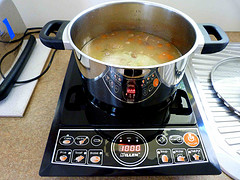
Induction cooking is the wave of the future. We say this jokingly. Patents on the idea date back a century, and demonstration models were shown to the public as early as 1950, however, the idea has never quite caught on.
In recent years, however, there has been a slight increase in interest in this technology. A traditional electric burner heats a coil, on which a cooking vessel is placed. An induction cooktop also uses electricity, but it runs current through an electric coil, creating a magnetic field. When the cookware is brought close to it, it induces an electric current in the pot, which dissipates as heat.
Like some newer electric stoves, the top of an induction burner is a glass-ceramic top. Because of the design, they are often safer than other cooktops. There are no open flames or explosive substances, as in gas. And the surface can be touched shortly after the cookware is removed, as it is much more energy efficient than other cooking methos..
There are limitations though. As induction works on the cookware, you need compatible cookware…specifically magnetic. We checked our existing cookware using a refrigerator magnet. If it doesn’t stick, or does so weakly, it is not sufficient. Stainless steel and iron cookware is ideal, aluminum and copper will not work. Being as your results will vary, you can get cookware that is labelled as induction ready. For example, we found a lot at Ikea at a reasonable price.
Covering that, the cooking properties of induction are most similar to gas. When you change the temperature, it happens immediately. There isn’t a gradual rise as there is in traditional electric cooking. It is why many chefs and cooking enthusiasts love it.
“Standing at an induction range, even great cooks must rethink their basic moves. The heat comes on so fast that anyone used to pouring oil in a pan and chopping the last of the onions while it heats is making a big mistake. Learning to control heat levels with numbered dials is like trying to master a new language.”
It makes it hard to make an omelette, and a learning curve. But we are slowly getting there.
If you are interested, a single plug-in burner can be had for between $50 and $100, like the one below.
[asa]B0045QEPY[/asa]
